Stagger means to take a 16-Matrix formation, typically
Interlocked Blocks [C1],
and to work as if you were in Columns. Upon completion of the
given call, each dancer must end on one of the footprints of the original
formation. Shape-changing calls are allowed with the restriction that it must
be possible for each dancer to unambiguously adjust to end on one of the
footprints of the original formation. When the starting formation is
Interlocked Blocks, the Diagonal acts as the controlling feature for
re-establishing the footprints of the resulting formation.
|
Stagger CONCEPT
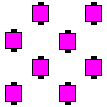
| |

| | From here... | | imagine you are here. |
|
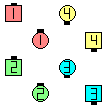
| |
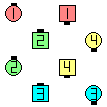
| before
Stagger Circulate | | after
|
|
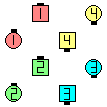
| |

| |

| |
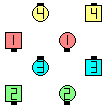
| before
Stagger Peel & Trail | | imagine you are in Columns | | after
Peel & Trail | | after
re-establishing footprints |
|
Stagger anything To A Line | Wave | normal setup [C2V]:
Start the given call Stagger but end in a normal setup (i.e., remove the
distortion). For example, a Stagger Coordinate To A Line starts from a
distorted setup but ends in Parallel Lines.
Split Stagger [C2V]:
Same as Stagger working Split. For example, a Split Stagger Counter Rotate 1/4
is the same as Stagger Split Counter Rotate 1/4.
Sometimes the caller will say Split Stagger in order to
emphasize that the call is to be done on a Split basis, when just Stagger
would have sufficed, as in Split Stagger Walk & Dodge (since Walk & Dodge
is a 4-dancer call it is always done on a Split basis when called from
Columns). We believe callers should avoid using the term Split Stagger.
Big Block CONCEPT [C3A]:
From applicable 4 x 4 Matrix formations such as
Interlocked Blocks,
a Butterfly,
or an
"O".
Do the call working in distorted Parallel Lines.
See also Block FORMATION [C1].